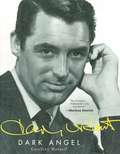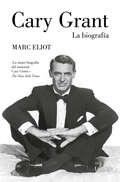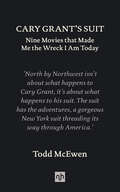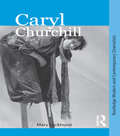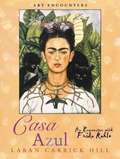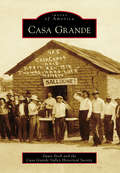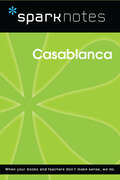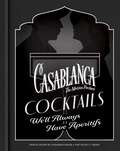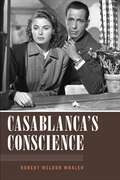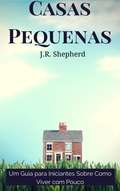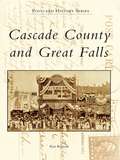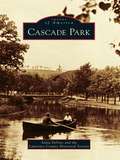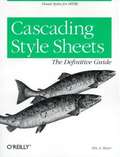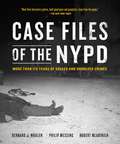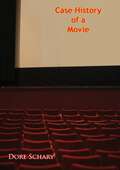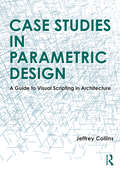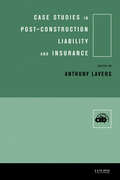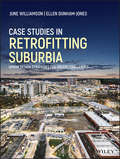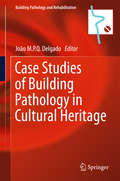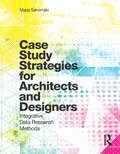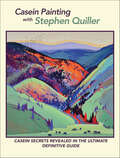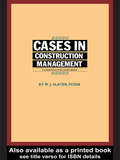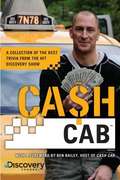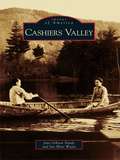- Table View
- List View
Cary Grant: Dark Angel
by Geoffrey WansellHis signature jaw line and charismatic characters made him an American symbol. His films, including Bringing Up Baby, The Philadelphia Story, and North by Northwest, were timeless classics. However, Grant was also married five times and sustained a tortured, obsessive relationship with money. In this beautifully illustrated and comprehensive book, Geoffrey Wansell traces the threads of both light and darkness in one of Holly-wood's greatest stars. As his friend and co-star Deborah Kerr wrote, he was "one of the most outstanding personalities in the history of the cinema."
Cary Grant: La biografía
by Marc Eliot«Todo el mundo quiere ser Cary Grant. Incluso yo quiero ser Cary Grant.» Con estas palabras resumía el propio Cary Grant el atractivo y la fascinación que su personaje público despertó en todo el mundo a lo largo de varias décadas. Considerado uno de los grandes mitos de la era dorada de Hollywood, pocos conocen, sin embargo, su vida privada, sus orígenes humildes en Inglaterra, donde nació y recibió el nombre de Archibald Alexander Leach, y los avatares que le llevaron a convertirse en uno de los actores más cotizados de su época. Marc Eliot ofrece en este libro, sin duda la biografía definitiva del actor, una amena y a la vez rigurosa narración de la vida de este gigante del cine, centrándose tanto en su intimidad -muy suculenta y salpicada de escándalos, divorcios y titulares- como en su faceta profesional, haciendo especial hincapié en su relación con sus directores favoritos: Howard Hawks, George Cukor o Alfred Hitchcock, el cineasta que mejor supo esculpir el irrepetible talento de Cary Grant, cuya enigmática mirada vuelve a hipnotizarnos en las páginas de este libro imprescindible.
Cary Grant’s Suit: Nine Movies That Made Me the Wreck I Am Today
by Todd McEwenA cinematic memoir and critical exploration of nine classics of old Hollywood by a contemporary comic novelist.&“North by Northwest isn&’t about what happens to Cary Grant, it&’s about what happens to his suit. The suit has the adventures, a gorgeous New York suit threading its way through America. The suit, Cary inside it, strides with confidence into the Plaza Hotel. Nothing bad happens to it until one of the greasy henchmen grasps Cary by the shoulder. We&’re already in love with this suit and it feels like a real violation.&”Todd McEwen grew up in Southern California, so his head was hopelessly messed with by the movies. As the son of relatively normal people, Todd had no in with Hollywood, a mere thirteen miles away, yearn and try as he might.This is a kid who loved the movies so much, he got up at 4:30 in the morning to watch Laurel and Hardy. A kid who insisted on his birthday that his father project 8mm cartoons onto the family&’s dining room curtains so they could be slowly parted, just like at a real cinema.This is a kid who liked to leave the movie and trudge up hundreds of dangerous iron steps to visit the lugubrious and always surprised projectionist. This is a kid who, years later, watched Chinatown over 60 times.A love letter to old Hollywood, this is a book for anyone interested in film. Movies discussed include Blotto, The Wizard of Oz, The Three Stooges, To Catch a Thief, North by Northwest, The 39 Steps, The Trouble with Harry, and many, many more.
Caryl Churchill (Routledge Modern and Contemporary Dramatists)
by Mary LuckhurstOne of Europe's greatest playwrights, Caryl Churchill has been internationally celebrated for four decades. She has exploded the narrow definitions of political theatre to write consistently hard-edged and innovative work. Always unpredictable in her stage experiments, her plays have stretched the relationships between form and content, actor and spectator to their limits. This new critical introduction to Churchill examines her political agendas, her collaborations with other practitioners, and looks at specific production histories of her plays. Churchill's work continues to have profound resonances with her audiences and this book explores her preoccupation with representing such phenomena as capitalism, genocide, environmental issues, identity, psychiatry and mental illness, parenting, violence and terrorism. It includes new interviews with actors and directors of her work, and gathers together source material from her wide-ranging career.
Casa Azul: An Encounter with Frida Kahlo
by Laban Carrick HillFrida Kahlo's work comes to life in this magical realist novel, the latest addition to Watson-Guptill's acclaimed Art Encounters series. The story alternates between Kahlo's home in Mexico City, Casa Azul, and the journey of a teenage girl and her young brother, lost in the city. At the mystical Casa Azul, everything with a face talks--including Kahlo's pet monkey, her cat, portraits on the wall. Over the course of the book, the cover painting,Self-Portrait with Thorn Necklace and Hummingbird, transforms from a nightmarish vision of death into a life-affirming masterpiece. This dramatic story offers a vivid reimagining of the life and work of a woman as well known for her amazing life as for her amazing art. *Laban Hill is a National Book Award Finalist and recipient of the Parents Choice Gold Award. * Frida Kahlo is one of the most popular artists among young people today-her art and her blazingly flamboyant style make her eternally up-to-date. * Ties in to school curriculum in art and social studies.
Casa Grande
by Casa Grande Valley Historical Society Dawn SnellCasa Grande, Arizona, is located on desert and farmland between Tucson and Phoenix and began as the end of an unfinished railroad line--thus its early name, Terminus. On May 19, 1879, when early summer heat halted construction of the railroad in what would soon become Casa Grande, only three buildings and five residents constituted the town. The names reflect the ethnic diversity of the sparse population: Buckalew, Ochoa, Smith, Watzlavocki, and Fryer. In September 1880, executives of the Southern Pacific Railroad Company named the town Casa Grande after the prehistoric Hohokam Indian ruins located 20 miles to the east. This volume illustrates how a desert railroad stop grew into a city. Today, as Casa Grande's population increases, new neighborhoods, schools, malls, and entertainment venues provide exciting new reasons for living here. However, as the population grows, the town struggles to retain its identity as an agricultural community.
Casablanca (SparkNotes Film Guide)
by SparkNotesCasablanca (SparkNotes Film Guide) Making the reading experience fun! SparkNotes Film Guides are one-stop guides to great works of film–masterpieces that are the foundations of filmmaking and film studies. Inside each guide you&’ll find thorough, insightful overviews of films from a variety of genres, styles, and time periods. Each film guide contains:Information about the director and the context in which the film was made Thoughtful analysis of major characters Details about themes, motifs, and symbols Explanations of the most important lines of dialogue In-depth discussions about what makes a film so remarkable SparkNotes Film Guides are an invaluable resource for students or anyone who wants to gain a deeper understanding of the great films they know and love.
Casablanca Cocktails
by Cassandra ReederOf all the gin joints, in all the towns, in all the world . . . not one is better than hosting at home. Filled to the brim with history, heart, and hard-crafted drinks, this cocktail book will bring the spirit of Casablanca to life for its legions of fans. ?Historically accurate recipes, contemporary reinventions, and Moroccan-inspired small bites find common ground rooted in film trivia. Plus, a "bar crawl" through unearthed props and archival material, and rendered in high-resolution photography, will give this classic cocktail book an interactive feel.? OFFICIAL EDITION: Made in partnership with Warner Bros. Entertainment Inc., this cocktail book imagines life as a regular at Rick&’s Café Americain. HERE'S LOOKIN' AT OVER 65 RECIPES: Learn to prepare drinks like the &“Gin Joint Jaunt&” and &“The Usual Suspects,&” not to mention hors d&’oeuvres like the &“Leading Banker&’s Banket.&” THE ULTIMATE BAR TRIVIA: From official scripts and internal memos to original props, this book is the perfect guide to getting your bar stocked and your mind sharp for the next trivia night.
Casablanca's Conscience
by Robert Weldon WhalenA new look at a beloved classic film that explores the philosophical dynamics of CasablancaCelebrating its eightieth anniversary this year, Casablanca remains one of the world’s most enduringly favorite movies. It won three Academy Awards for Best Picture, Best Director, and Best Adapted Screenplay. It is still commonly quoted: “We’ll always have Paris” and “Here’s looking at you, kid” And who can forget, “You must remember this…a kiss is just a kiss.” Yet no one expected much to come of this little film, certainly not its blockbuster stars or even the studio producing it. So how did this hastily cranked-out 1940s film, despite its many limitations, become one of the greatest films ever made? How is it that year after year, decade after decade, it continues to appear in the lists of the greatest movies ever produced? And why do audiences still weep when Rick and Ilsa part? The answer, according to Casablanca’s Conscience, is to paraphrase Rick, “It’s true.”Much has already been written about the film and the career-defining performances of Bogart and Bergman. Casablanca is an epic tale of love, betrayal, and sacrifice set against the backdrop of World War II. Yet decades later, it continues to capture the imagination of filmgoers. In Casablanca’s Conscience, author Robert Weldon Whalen explains why it still resonates so deeply. Applying a new lens to an old classic, Whalen focuses on the film’s timeless themes—Exile, Purgatory, Irony, Love, Resistance, and Memory. He then engages the fictional characters—Rick, Ilsa, and the others—against the philosophical and theological discourse of their real contemporaries, Hannah Arendt, Dietrich Bonhoeffer, and Albert Camus. The relationships between fictional and historical persons illuminate both the film’s era as well as perennial human concerns. Both the film and the work of the philosophers explore dimensions of the human experience, which, while extreme, are familiar to everyone. It’s the themes that resonate with the viewer, that have sustained it as an evergreen classic all these years.
Casas Pequenas: Um Guia Para Iniciantes Sobre Como Viver Com Pouco
by J. R. Shepherd Matheus Müller Pereira Da SilvaDescrição do livro:Viva feliz por viver com pouco!Já imaginou como seria viver em uma casa pequena? Sonha em ter uma hipoteca menor? Ou absolutamente nenhuma? Importa-se em viver "verde"? Gostaria de viver com maior simplicidade e focar nas coisas que são realmente importantes na vida? Então uma Casa Pequena pode ser a solução perfeita para você!Este livro explora as Casas Pequenas e o estilo de vida que as acompanha. Ele irá dar-te uma perspectiva de como uma Casa Pequena poderia se encaixar para você e ajudá-lo a explorar a ideia de viver grande em um espaço pequeno.Dentro de Casas Pequenas: Um Guia para Iniciantes Sobre Como Viver com Pouco, você irá aprender:- Para quem as Casas Pequenas são mais adequadas- Como Casas Pequenas te ajudam a diminuir suas posses desnecessárias e focar nas coisas que são realmente importantes para você- Dicas de Design e Decoração que irão te ajudar a aproveitar melhor o espaço da sua Casa Pequena- Os benefícios Físicos e Emocionais de adotar um estilo de vida de Casa Pequena- E muito, muito mais!Casas Pequenas são sobre focar no que mais importa para você - relacionamentos, hobbies, trabalho, natureza ou comunhão. Nunca é tarde demais para mudar o foco, e Casas Pequenas: Um Guia para Iniciantes Sobre Como Viver com Pouco irá te ajudar a chegar lá!Viva feliz por viver com pouco!
Cascade County and Great Falls
by Ken RobisonGreat Falls, on the Missouri River, began as a city of sun, water, and future. Long a crossroads for Native Americans, in 1805, the Lewis and Clark Expedition portaged the great falls of the Missouri. Early development combined electrical power from dams with mineral resources from nearby mountains to power smelters and refineries. The railroad stimulated growth as Great Falls became a dynamic "Electric City" at the heart of the mountains and valleys of Cascade County. Today the river, ranching and farming, regional retail, and medical facilities combine with cultural and recreational tourism and Montana's largest military presence. Great Falls boasts Montana's greatest ethnic diversity, with the state's largest Native American and African American populations. A world-class symphony and the renowned Charles M. Russell Museum help round out Great Falls as Montana's "All-American City."
Cascade Park (Images of America)
by Anita Devivo Lawrence County Historical SocietySince its opening in 1897, Cascade Park has welcomed thousands of visitors to its picnic grove, summer cottages, mineral springs, dance pavilion, swimming pool, baseball field, zoo, boat rides, outdoor theater, fireworks, and numerous other amusements. The park is an unusually beautiful natural setting with Big Run Falls, Cat Rocks, a gorge, rolling hills, shady walkways, and even a ginkgo tree or two. In the 1890s, when it was called a trolley park, crowds of visitors arrived by streetcar. Eventually automobiles took over, and the roller coaster was dismantled to make space for a parking lot. Today automobiles spill out of the parking lot once a year when more than 1,000 vintage cars travel to the Back to the 50's Weekend, now in its 25th year. This and other family-oriented events continue the tradition of good times in Cascade Park.
Cascading Style Sheets: The Definitive Guide
by Eric MeyerCascading Style Sheets (CSS) is the HTML 4.0-approved method for controlling visual presentation on web pages. This comprehensive guide to CSS and CSS1 explores in detail each property, how individual properties interact, how to avoid common mistakes in interpretation. For both beginning and advanced web authors, this is the first major CSS title to address actual current browser support, rather than the way things work in theory.
Cascading Style Sheets: The Definitive Guide
by Eric MeyerCascading Style Sheets (CSS) is poised to make its mark on the Web. With good implementations in Internet Explorer 5.0 and Opera 3.6, and 100% support expected in Netscape's "Mozilla" browser, signs are that CSS is rapidly becoming a useful, reliable, and powerful tool for web authors. CSS is the W3C-approved method for enriching the visual presentation of web pages. Cascading Style Sheets: The Definitive Guide offers a complete, detailed review of CSS1 and CSS positioning, as well as an overview of CSS2. Each property is explored in detail with a discussion of how each interacts with other properties. There is also information on how to avoid common mistakes in interpretation. This book is the first major title to cover CSS in a way that both acknowledges and describes current browser support, instead of simply describing the way things work in theory. It offers both web authors and scripters a comprehensive guide to using CSS effectively. Cascading Style Sheets: The Definitive Guide targets veteran web authors who have already invested thousands of hours in learning HTML and writing web pages and are wondering why they need to learn a brand new language of style. This book supplies those dubious but curious web authors with the information they need to easily implement CSS for their web site. This book also addresses an audience of novice web authors who are already straining to learn all of the tags and attributes of HTML and can benefit now from implementing CSS correctly instead of repeating the mistakes of the past. The author has extensive experience writing about pitfalls and interesting tricks in CSS. He is a member of the CSS and FP Working Group, coordinates the W3C's CSS1 Test Suite, remains active on CSS newsgroups, and edits Web Review's Style Sheets Reference Guide. He has built a widespread reputation as a CSS expert, particularly with regard to his understanding of the intricacies of browser support for CSS. He brings his knowledge and expertise to this book in the form of hints, workarounds, and many other tips for web authors.
Case Files of the NYPD: More than 175 Years of Solved and Unsolved Crimes
by Robert Mladinich Bernard Whalen Philip Messing"Characters galore, both good guys and gangsters, leap from the pages" (The New York Times) in this irresistible, authentic look at 175 years of true crime cases from the NYPD archives, packed with photos, artifacts and expert revelations. From atrocities that occurred before the establishment of New York's police force in 1845 through the terrorist attack on the World Trade Center in 2001 to the present day, this chronological visual history is an insider's look at more than 80 real-life crimes that shocked the nation, from arson to gangland murders, robberies, serial killers, bombings, and kidnappings, including: Architect Stanford White's fatal shooting at Madison Square Garden over his deflowering of a teenage chorus girl. The anarchist bombing of Wall Street in 1920, which killed 39 people and injured hundreds more with flying shrapnel. Kitty Genovese's 1964 senseless stabbing, famously witnessed by dozen of bystanders who did not intervene. Robert Chambers, the handsome, wealthy ex-Choate student, who murdered Jennifer Levin in Central Park, called "The Preppy Murder Case." Son of Sam, a serial killer who eluded police for months while terrorizing the city, was finally apprehended through a simple parking ticket. Perfect for crime buffs, urban historians, and fans of American Crime Story, this riveting collection details New York's most startling and unsettling crimes through behind-the-scenes analysis of investigations and more than 250 revealing photographs.
Case History of a Movie
by Dore Schary"Case History of a Movie" documents the behind-the-scenes record of a low-budget studio film from 1950. The movie was "The Next Voice You Hear", which was directed by William Wellman and starring James Whitmore and Nancy Davis (Reagan).“I have always wanted to do a book which would state realistically and in detail how a motion picture is made. I had reserved this plan for some time in the future, when other men will be doing the work I am now doing, and when I would be able to look back and reflect on the enjoyable effort of most of my lifetime.However, the making of the film, The Next Voice You Hear, was so stimulating that it propelled me into attempting this job long before I actually had the full time to do it. Help came along in the form of one Charles Palmer, an experienced, capable writer who tackles his assignments with the wide-eyed enthusiasm of an apprentice who has just sold his first by-line to the local gazette. “Cap” (for his initials) shares my enthusiasm for films, knows his way around the studios, and has skill and experience with the printed word. He was willing to take on this collaborative and “as told to” assignment, and I am delighted he did, because even though I have not been able to write all of this book, it is exactly the way I would have wanted to write it. Cap did most of the putting together of the words from notes taken at sessions we had during free hours in the morning, or at night, or on Sundays; from some articles I had worked on; some speeches I had made; from my own dictated comments and handwritten scrawls—and finally, from his own keen eye and his own talent.”-Foreword
Case Studies in Parametric Design: A Guide to Visual Scripting in Architecture
by Jeffrey CollinsCase Studies in Parametric Design is a guide to scripting digital models for architects, designers, and builders. The use of parametric design in architecture has afforded the realization of incredible built work; modelling software can resolve complex geometry and aid in the development of stunning creations. Methods for creating the digital models to achieve these results, however, can be perplexing. Learning curves are steep, and benefits garnered from adapting existing workflows to incorporate new tools may appear trivial. This book describes programming techniques for a variety of buildings and provides novices an understanding of language and processes, challenges intermediate users with rigor and intentionality, and offers proficient practitioners objectives beyond novel form-making. The case studies consist of six mass topologies and six facade topologies; each includes sample topology models and scripts, descriptions of steps for generating customizable parametric models, and suggestions for additional modelling inquiries. This is essential reading for students and practitioners interested in harnessing the full potential of parametric design.
Case Studies in Post Construction Liability and Insurance
by Anthony LaversThis comparative international review of law and practice liability describes the framework in which lawyers, insurers, contractors and clients dealing with liability operate. The act of building involves risk and, in the case of damages occurring after construction, it is often hard to identify responsibility.This will be an essential reference for construction lawyers, insurers and other senior practitioners and managers in industry, based on research and analysis by CIB (Conseil International du Batiment) as part of the CIB series programme.
Case Studies in Retrofitting Suburbia: Urban Design Strategies for Urgent Challenges
by June Williamson Ellen Dunham-JonesA brand-new collection of 32 case studies that further demonstrate the retrofitting of suburbia This amply-illustrated book, second in a series, documents how defunct shopping malls, parking lots, and the past century’s other obsolete suburban development patterns are being retrofitted to address current urgent challenges they weren’t designed for: improving public health, increasing resilience in the face of climate change, leveraging social capital for equity, supporting an aging society, competing for jobs, and disrupting automobile dependence. Case Studies in Retrofitting Suburbia: Urban Design Strategies for Urgent Challenges provides summaries, data, and references on how these challenges manifest in suburbia and discussion of successful urban design strategies to address them in Part I. Part II documents how innovative design strategies are implemented in a range of northern American contexts and market conditions. From modest interventions with big ripple effects to ambitious do-overs, examples of redevelopment, reinhabitation, and regreening of changing suburban places from coast to coast are described in depth in 32 brand new case studies. Written by the authors of the highly influential Retrofitting Suburbia: Urban Design Solutions for Redesigning Suburbs Demonstrates changes that can and already have been realized in suburbia by focusing on case studies of retrofitted suburban places Illustrated in full-color with photos, maps, plans, and diagrams Full of replicable lessons and creative responses to ongoing problems and potentials with conventional suburban form, Case Studies in Retrofitting Suburbia: Urban Design Strategies for Urgent Challenges is an important book for students and professionals involved in urban design, architecture, landscape architecture, urban planning, development, civil engineering, public health, public policy, and governance. Most of all, it is intended as a useful guide for anyone who seeks to inspire revitalization, justice, and shared prosperity in places they know and care about.
Case Studies of Building Pathology in Cultural Heritage (Building Pathology and Rehabilitation #7)
by João M.P.Q. DelgadoThis book highlights newdevelopments in the field of building pathology and rehabilitation, taking anin-depth look into current approaches to the surveying of buildings and thestudy of defect diagnosis, prognosis and remediation. Including a number of real-worldcase studies and a detailed set of references for further reading, the bookwill appeal to a wide readership of scientists, practitioners, students andlecturers.
Case Study Strategies for Architects and Designers: Integrative Data Research Methods
by Marja SarvimakiCase Study Strategies for Architects and Designers explains methods in evidence-based design, also called practice-based research, to show you the value of research to your designs. Topics covered pertain to data collection and analysis techniques, including surveys, interviews, fieldwork, participatory design, occupancy evaluations, and memory sketching. Integrative data evaluation, theoretical sampling, triangulation, pattern matching logic, and analytical generalization are also discussed. Global research precedents, exercises, further reading, section summaries, sidebars, more than 30 black and white images and tables will help you conduct empirical inquiries in real-life contexts.
Casein Painting with Stephen Quiller: Casein Secrets Revealed in the Ultimate Definitive Guide
by Stephen QuillerCasein Secrets Revealed in the Ultimate Definitive Guide In this important book, Stephen Quiller unveils the many secrets of casein. Travel with him through a span of 50 years as he discovers and reveals the beautiful visual qualities and handling characteristics of this important painting medium.
Cases in Construction Management
by W.J. SlaterWritten by the country's leading authority on construction management training, this book gives practical examples of construction management problems and how to deal with them.
Cash Cab
by Discovery Communications Ben BaileyThe fast-paced, fact-driven, backseat game show fans can now play without hailing a taxi. It's the best, the most challenging, and the most popular questions from Cash Cab-and they're all no fare.Features: Organized for easy one-on-one read-along trivia, or game playing mode Hundreds of multiple-choice questions that vary in degrees of difficulty for novice trivia buffs to frontseat know-it-alls Popular "red-light challenges" and "shout-outs" Page after page of trivia sidebars and fascinating facts Cash Cab host Ben Bailey's favorite places to visit in New York
Cashiers Valley
by Jan Blair Wyatt Jane Gibson NardyCashiers Valley, enveloped in the Blue Ridge Mountains with craggy stone faces, thundering waterfalls, majestic forests, and wilderness areas of unique flora and fauna, has always drawn visitors.Its moderate climate, slower pace, and friendly people have encouraged visitors to stay and, increasingly, to relocate. The residents have preserved a strong sense of place as they embraced the bonds of kinship and community through the years. This is all connected to a powerful religious base and a strong cultural heritage tradition. Today Cashiers Valley retains the charm of an isolated mountain village that welcomes guests. The photographs in this volume were gathered from manylocal scrapbooks, long forgotten and yellowing with age. Community residents are eager to share their photographs and memories of days gone by.
